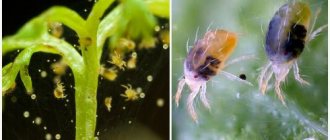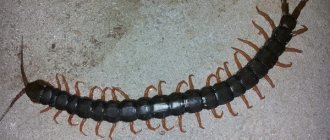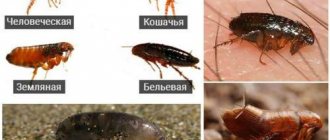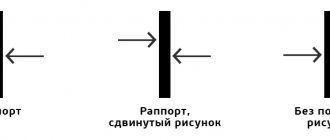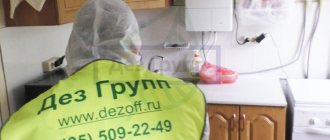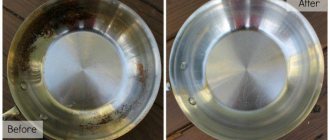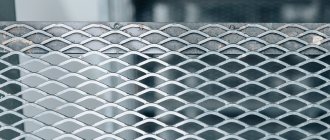When talking about fighting bugs in an apartment, different people may mean completely different parasites, so first of all you need to decide which one you are talking about. Beetles often include any insects whose names are not known for sure. Most often found in houses:
- Cockroaches
- Bedbugs
- Mosquitoes
- Clothes moth
- food moth
- Lice
- Fleas
- Woodlice
- Bark beetles
- Carpet beetles
- Herbivorous mites
Pests can feed on:
- Human food
- Plants
- Blood and skin of people and animals
- Textiles
- tree
What exactly they eat depends on where they live. Formally, domestic parasites can be divided into 3 groups:
- Plant pests.
- Pests that spoil food and things.
- Parasites that feed on the human body.
How to deal with beetles in an apartment depends on what category the insects that have appeared in your home belong to. Plants need special products that can solve the problem without causing harm to leaves, roots, flowers and shoots. When exterminating blood-sucking pests, in addition to preparations for baiting the arthropods themselves, skin treatment products are needed. Any annoying insects in the house can be exterminated with the help of SES specialists. This is especially true if pests are not interested in house flowers, but are aimed at your food, waste, or you.
Where do bugs come from in an apartment?
When the owners notice that black beetles have appeared in the room, despite the fact that there is no disorder in the room and the cleaning was carried out on time, the question immediately arises where they could come from.
Ways of appearance of beetles in an apartment:
- cracks in walls, window frames, into which small insects can easily crawl;
- ventilation shafts and openings in which protective nets are not installed;
- windows and vents, open for ventilation, can become an “entrance door” through which flying insects fly into the apartment;
- through risers of sewer and water pipes;
- black beetles appear in apartments in the summer, clinging to people’s shoes or clothes, thus penetrating the living rooms and kitchen;
- from a neighboring basement or attic.
Security measures
A house poison is required, in accordance with a number of safety recommendations.
Chemicals can cause intoxication and allergic reactions. It is forbidden to treat people prone to allergies, pregnant and lactating women.
It is necessary to poison bedbugs in the apartment yourself, observing the following rules:
- use gloves;
- use a gauze bandage;
- wear closed clothes;
- close your head;
- After the process, wash your hands and face thoroughly;
- leave the house for a while;
- take off your clothes and wash yourself.
Photos and names of black beetles
You can determine exactly what the black beetle in the house is called by its appearance and size, as well as its location. They can settle both in food and in furniture, carpets or wooden structures and walls.
The most common black beetles, which sometimes settle in an apartment or private house, are beetles or flour beetles. They received their second name because they prefer to eat cereals and other bulk products.
In total, there are 3 types of Khrushchak:
- large beetles - differ in their length (up to 13 mm);
- small – have a size of up to 3.6 mm;
- black - distinguished by black color.
Black beetles in the apartment
In addition to the flour beetle, there are other types of small black bugs in the apartment:
- skin beetles - small black insects up to 4 mm in size that feed on fur and leather products, paper from books, indoor plants and food (flour, nuts, cereals, meat, etc.) - live in closets, old clothes, crevices of furniture; dangerous because they can carry infections and helminths;
- carpet beetles - they settle in beds and carpets, feeding on old peeling human skin, hair and crumbs; they can render things unusable and also cause allergies in some people;
- fleas are small jumping parasites that bite painfully and can carry infection; they often appear in homes where cats and dogs live.
Prevention measures
- To avoid the appearance of bugs in the apartment, it is necessary to ventilate the room as often as possible, especially kitchen cabinets.
- It would be a good idea to wipe them from the inside with a cloth soaked in vinegar.
- When buying cereals and pasta, you need to look at the packages with their contents, as they may already contain pests.
- When purchasing furniture, you should also inspect it for the presence of characteristic holes.
- It is advisable to treat all wooden materials that are used to decorate the apartment with an antiseptic (Antizhuk, Wood Healer).
- To prevent bugs such as springtails from appearing in your apartment, you should not over-moisten the soil in which the plants grow. In addition, it is a good idea to sprinkle some ash on top of the soil.
- Stocks of cereals can be stored on the balcony in winter to prevent beetles from infesting.
- And, of course, keep the apartment clean, vacuum furniture and carpets more often, treat them with steam, and prevent dampness in the bathrooms; Take out the trash promptly.
Big Khrushchak
According to the biological classification, Khrushchev beetles belong to the Darkling beetle family, numbering 11 species, of which only 3 are common in Russia and Moscow.
Khrushchak is a large black beetle up to 1.8 cm long, its body is flattened, and there are only 6 legs (3 pairs). The color of the body is black-brown and shiny, the abdomen has a reddish tint. Females lay 200 eggs. into the nest. The pest larva (popularly called a mealworm) is larger in size, up to 2.5 cm, and brownish-yellow in color. It feeds on grain, flour and bran. As the larva grows, it undergoes 4 molts.
The flour beetle chooses as habitats in the apartment those that are located near its favorite food. In nature, they prefer to live in tree hollows or rotten parts. The beetle's main diet consists of animal food (the corpses of small mammals and insects) and plant food.
When settling in an apartment, beetles look for food in the form of grain, flour, cereals or bran. They spoil food supplies, contaminating them with their excrement, skins from larvae and dead insects. In a short time, black bugs can multiply and infest all your kitchen cabinets and drawers.
Mucoeds
They are polyphagous beetles, that is, their menu is very diverse. Three types can be found in apartments.
Surinamese
A beetle 3-3.5 mm long with a red-brown back. The pest is flat, very elongated in length, with a thin body. The pronotum has characteristic longitudinal “ribs”.
Prefers bakeries as a bottomless source of nutrition. But often, along with flour and cereals, it gets into apartments, where it infects other supplies. The vital activity of bugs leads to an increase in humidity in products, which is why mold forms in cereals.
Maximum lifespan 3 years. Usual 6-10 months. The life cycle is 27-51 days at a temperature of 29-35°C.
During her life, the female lays 43-285 eggs. At an ideal temperature of 27-29°C, the larvae hatch after 3-5 days. The larva grows up to 3 mm, has a yellow-white color and a brown head.
Red mukoed
The light brown beetle is approximately 2 times smaller than its Surinamese “brother”. In the apartment, the food supply, habitats and life cycle are similar to those of the Suriname mucoedeater. A distinctive feature of the red mucous eater is inactivity.
Mucoeds
Merchant beetle
A flat small beetle, 2.5 cm long. Almost completely identical to the Surinamese beetle in morphology and lifestyle, differing in eye size and head shape. The bugs crawl actively, moving to new habitats.
Small Khrushchak
The small flour beetle has a brown or red body color and causes considerable damage to the food supply of a person in an apartment. It is widespread in Russia and Ukraine, where it often causes spoilage of grain in granaries, mills and other places where bulk products are stored.
The red-brown beetle is smaller in size (up to 3.6 mm), but it loves to settle in various food supplies in the apartment: flour, nuts, dried fruits and other plant fruits.
Unlike the large Khrushchak, the small one has wings and is able to fly. The males of such a flying insect have an abdomen rounded at the end and covered with hairs. In females, the tip of the body is bare; they are capable of laying up to 1 thousand eggs.
The larva of the small beetle has a flat shape and a length of up to 7 mm, the body color is yellow-brown (light or dark shades), the head is flattened. The body is covered with hairs and ends with 2 spines. The pupa is painted light yellow, and its body is shiny and completely naked. The development cycle of the flying black beetle is 20-120 days, and the growth rate directly depends on the amount of food and living conditions.
Woodlice
These insects have an oval body of light gray, white, beige or brown, convex on top, and consists of several segments. The bug has 7 pairs of legs and a hard shell, and in front there are antennae up to half the length of the body. In nature, woodlice love damp places, which is where they got their name, but sometimes they settle near human habitation. They can climb into the cellar and into some rooms in the house (bathroom or toilet) where there is high humidity.
Penetrating into living spaces, woodlice can not only frighten people who are disgusted by insects that run quickly, but due to moisture and mold they become carriers of various fungal diseases, which pose a danger to human health.
Therefore, it is imperative to combat such moisture-loving insects, taking all possible measures to destroy them.
Black Khrushchak
The 3rd type of beetle has a darker, almost black body color, the size of which is up to 5.5 mm. Their body color is matte, the color varies from black to brown.
Unlike other species, small black beetles prefer to live only in heated rooms. By settling in the kitchens of people's houses and apartments, they are capable of ruining not only food products, but also glue, fabrics (knitwear and nylon) and other products. They are found much less frequently than their large and small counterparts. The larvae grow to a size of 12 mm.
Skin beetle larvae
The larvae begin to look for food and feed intensively immediately after they are born. Before they grow up, they need to go through 5 stages of development. To undergo a molt, to turn from a caterpillar into a beetle. The length of the caterpillar at the last stage of development is about 7 mm. The body is covered with thick hairs, somewhat similar to silverfish. The larva of the genus Anthrenus likes to be on the surface of fabric coverings and clothing. Larvae of the genus Attagenus live in dry bulk foods. They can be found at the bottom of boxes, bags, on carpets, under parquet floors. Unlike adult leather beetles, the larva does not like bright light. It lives in shady areas, poorly lit or in darkness.
The number of molts and the total duration of larval development depends on nutrition, humidity and temperature. The most favorable range is from 20 to 30 degrees. Under unfavorable conditions, the larva may be in a state of relative dormancy when development stops. The last molt ends with pupation. The pupal phase lasts from 4 to 20 days. Young beetles, having emerged from the pupa, remain in the “cradle” for several days. Then they begin searching for a partner to mate with. Within a year, 1 generation of leather beetles appears.
Methods to combat bugs
If black beetles appear in the apartment, then first you should determine their type based on external signs.
Depending on the identification, you can use various control methods to help get rid of black beetles:
- Carpet beetles and carpet pests should be combated by treating carpets and furniture; first they must be wiped with a sponge soaked in a soap solution, and then with a vinegar solution; a day after treatment, carpets and furniture should be vacuumed well, and the contents of the bag should be thrown away, as there may be insect eggs in there;
- to destroy flour beetles, it is necessary to carefully sort through all reserves of bulk products (flour, cereals, sugar, etc.); if they are found, everything must be thrown away, because they are not suitable for consumption;
- inspect the contents of all cabinets for small black or red bugs, then make a solution of 1 tbsp. l. soda per 1 liter of water and treat all surfaces and shelves inside the cabinets, wash the dishes using detergents and pour boiling water over them;
- wash all surfaces in the kitchen with a solution of acetic acid or use boric acid powder, which should be rubbed into areas where parasites may live;
- treat the floor covering and baseboards with any aerosol containing an insecticide against insects (Dichlorvos, Combat, Raid, etc.);
- clothes should be boiled or washed in hot water (not lower than +60°C).
The procedure for exterminating insects should be repeated 2 times a week for a month, since new generations of bugs will hatch from the laid eggs of insects, which also need to be destroyed.
If the measures taken do not help or there is no time to fight bugs in the apartment for a long time, then it is better to turn to professionals. There are companies that use special preparations to carry out disinfestation (extermination of pests) in any residential premises.
Fighting bugs in the house
When should you contact a specialist?
When it comes to food bugs, disposing of affected foods, thorough cleaning, and preventive traps in cabinets will combat the problem. But in the case of bedbugs and rams, everything is much more complicated. Folk and chemical remedies will solve the problem only for a while. The best solution would be to involve professionals using products that are not sold in regular stores.
If such a problem arises and professional treatment is necessary, you need to prepare the apartment for disinfestation. First of all, cover all furniture, remove all food and hygiene products that may contain toxic chemicals. To clean your home from bedbugs, specialists need to provide free access to baseboards, mattresses, beds, sofas, etc.
There is no need to remove the dishes; there may be cockroach larvae on them. It is also fully processed. At the time of treatment, all residents and animals must leave the house for three hours. After this time, the room must be well ventilated. The floors cannot be washed for 24 hours, since the death of the insect occurs not from inhaling the poison, but directly from contact with it. After disinfestation, you should wipe down door handles, kitchen counters and other surfaces.
Bark beetles and other inhabitants of wooden houses
In addition to the above beetles that settle in apartments, there are also specific species that live in a wooden house. Most often, insects enter the house along with contaminated building materials and pose a great danger to all wooden structures and furniture. They are capable of not only destroying valuable property in a short time, but also turning all the walls and structures of a building into dust.
They differ in that their main food is wood:
- bark beetles - a large group of beetles (750 species), the size of the insect is 5-10 mm, in the forest bark beetles carry out sanitary work, destroying rotten trees, and in a wooden house they are considered pests, they gnaw long passages in the wood and destroy it, insect larvae are capable of in a few years “eat” the whole house;
- grinders are long, oblong small bugs, 2-10 mm in size, black or brown in color, they are coleopteran insects, dangerous for wooden structures, furniture, books and cardboard, they also feed on grain reserves, making characteristic ticking sounds; at the slightest danger they pretend to be dead, black beetles are active in the house at night and can only be identified by rustling and other sounds;
- longhorned beetles are larger pests (up to 35 mm in size) of black, brown or blue-green color, with large mustaches (10 times longer than the body), the larvae are large, up to 3 cm in size, capable of damaging a wooden frame in a private house, transforming structures to complete ruin in a relatively short period of time, they prefer to settle in coniferous wood (in partitions, floors, on the roof, etc.).
Bark beetles
All beetles that chew on wooden walls or furniture in the house make a characteristic sound, similar to the ticking of a mechanical watch. In the old days, such parasites were called “death clocks”, due to the fact that their activity often led to the collapse of wooden houses and the death of their inhabitants.
The development of beetles that feed on wood follows the same pattern. Females lay eggs in crevices, from which larvae hatch and gnaw into wood walls. They gnaw passages in it and spoil the appearance and structure of wooden walls and ceilings. After the larvae transform into pupae, adults crawl to the surface.
Shashel
You can read more about the insect in the article: How to get rid of shashel.
Chashel often refers to beetles that damage furniture. Often all these insects are referred to by one term, although in fact the shashel is a black barbel. Externally, longhorned beetles differ from other grinders in appearance. They are black, with whitish patches, and have a large head with antennae and wings. Body length – 15-40 mm.
The difference between them and other insects that attack wood is that they prefer coniferous trees - fir, spruce. They live mainly in coniferous and pine forests.
The methods of control are the same as with other beetles that damage wood. They love fresh wood and can be found in warehouses, from where they enter homes.
Fighting tree beetles
The most effective and simplest way is to take preventive measures, i.e. treating construction wood with special antiseptic agents, which will protect all structures from pests.
However, if such domestic beetles have already settled in a wooden house, then there are several recipes for their extermination. The peak of their activity occurs in May-June; it is during these months that the fight will be most effective.
Folk remedies for exterminating pests in wood:
- the use of petroleum jelly, which is injected with a syringe into the found passages and holes in the tree, you can fill them with wax;
- mix turpentine and kerosene in a ratio of 3:1 and pump into the cracks and passages;
- a mixture of naphthalene (10 g) and gasoline (100 ml) is applied to the surface of the wood with a brush;
- one of the effective ways is to warm up the rooms in the house with hot air (at a temperature of +60°C) or by freezing them in winter frosts (at -5...-10°C);
- fill the passages and crevices with a mixture of naphthalene, resin and carbolic acid;
- spraying a solution of copper sulfate with a syringe;
- Before starting work, it is better to clean the holes in the walls with wire.
In addition to traditional methods and solutions, experts recommend using chemicals:
- insecticides containing cypermethrin, organophosphorus compounds and lambda-cyhalothrin, the most effective of these chemicals is Fufanon, which should be treated at least 2 times with an interval of 2 weeks;
- aerosols Prima-71, Bichromat, Dichlorvos - are used to combat larvae in July.
If, after the measures taken, black and gray bugs still remain in the tree, then you should seek help from specialists who will help neutralize the wooden house from dangerous pests.
Small bugs appear in any apartment from time to time, some of them cause serious harm, as they spoil furniture, things and food. Moreover, there are bugs that can bite a person, causing a lot of trouble.
Bugs in the apartment - photos and names
Woodworm
- The bug is no more than 3 mm in size and is brown, sometimes black.
- The danger comes from the larvae of this beetle, which can live in wood for many years.
- These pests literally turn the tree into “wood dust.”
Book louse
- A very small bug. Its body length is only 1 mm.
- Color - various shades of brown.
- In an apartment, the pest lives on bookshelves, as it feeds on the glue under the bindings of books.
- It is very dangerous for home libraries, as it can significantly spoil the appearance of books and albums.
Carpet beetle
- A small brown bug. The length of its body is no more than 5 mm.
- He feels good in apartments, as he eats foods available in the kitchen and various cereals.
- In addition, it can cause more serious damage, damaging furniture, carpets, as well as wool, silk and leather products.
- Finally, the bug is dangerous to humans because it bites, and therefore can infect a person with infectious diseases or provoke allergies.
Bark beetle
- The bug is extremely dangerous.
- Body length reaches 1.5 cm.
- It lives under the bark, feeding on wood. Pest larvae feed on tree sap.
- This pest and its larvae can quickly destroy everything in an apartment that is made of wood.
- It is very difficult to get rid of this type of bugs.
Flour beetle
- The bug is brown in color.
- The length of its body is from 5 mm to 2 cm (small and large Khrushchak, respectively).
- A small mealworm lives in a person’s apartment. He lives in the kitchen.
- It multiplies very quickly.
- In a short time it can spoil flour, various cereals, pasta and dried fruits.
- The larvae of this pest are called mealworms.
springtail
- A small white bug. Body length up to 1 cm.
- Lives in flower pots.
- It feeds on the roots and leaves of plants.
- It easily spreads from one plant to another, as a result of which the latter begin to wither and die.
- Springtails love moist soil, so you should avoid over-watering indoor plants in your apartment.
Grinder
- A relatively small bug. Its body length ranges from 1 mm to 1 cm; It even looks cute.
- Color – dark brown, black.
- Sensing danger, the pest immediately pretends to be dead.
- The beetle makes sounds by which you can understand that the pest has entered the apartment and has begun its destructive activities. These sounds are similar to the ticking of a clock.
- The larvae of these insects are very dangerous. They eat up to 99% of the wood.
- The apartment is usually inhabited by furniture, comb-whiskers and bread grinders.
- The furniture grinder literally eats furniture, making holes in the wood with a diameter of up to 3 mm.
- The comb grinder, as the name suggests, has long mustaches. The pest stays deep in the wood until it is completely destroyed.
- But the bread grinder prefers to wood the more delicious food that he finds in a person’s kitchen. These are, naturally, various cereals, pasta, dried fruits, etc.
Silverfish
- The bug is small.
- It has a beautiful silver color.
- It loves warmth and moisture, so in an apartment it can be found in the toilet, in the bathroom, at the kitchen sink.
- It feeds on sugar, starch, as well as any products containing these components.
- The bug is not dangerous for humans, since it does not bite and, therefore, is not a carrier of infections.
Shashel
- The bug is very small. Its body length is only 3 mm.
- Can fly.
- The color is most often black.
- This pest lives in wooden furniture and wooden walls.
- The larvae of this insect make passages inside the tree, from which dust then falls. And if such rot is noticed, it is necessary to urgently take measures to destroy the bugs.
House woodlice
Woodlice cannot be classified as insects that live in apartments - these arthropods are a type of higher crayfish.
They do not cause much harm to humans: only occasionally woodlice can damage stocks of vegetables or damage young shoots of domestic plants. However, meeting these miniature roommates is not always pleasant.
The life activity of woodlice is to a certain extent connected with water, and therefore getting rid of them is quite simple. As a rule, to do this you only need to eliminate moisture: for example, fix a leak in the faucet, dry out the bathroom. If these measures do not bring the desired effect, then you can get rid of woodlice using any insecticidal preparation (Delta-Zone, Get, Dobrokhim FOS, Tsifoks, etc.).
Carpet beetles
They are one of the most striking examples of insects in an apartment, with which the owner most often does not even suspect cohabitation. The reason is very simple to explain: adult individuals barely reach the size
In general, there are quite a few different types of skin beetles; in the natural environment, they almost always settle in places where there is an abundance of some organic remains of the vital activity of birds or animals. If we look at an apartment, then these insects settle in places where there is clothing, leather or paper.
In residential areas, these insects feed on books, wardrobe items, and so on. It should be noted that skin beetles are real “generalists” in their food preferences: they can be seen, among other things, in herbariums and cereals. They can even feed on debris in dust and multiply behind baseboards for a long time.
As a rule, skin beetles are removed using various aerosol insecticides, but traditional methods, in the case of these pests, can significantly help. So, for example, the larvae of these insects cannot stand the smell of wormwood and lavender.
Silverfish
These are probably the most “quiet” and almost harmless insects. In terms of their way of life, they can be compared, for example, with woodlice: these tiny roommates also love warmth, darkness and moisture.
These pests feed on various organic matter found in dust, bread crumbs, sugar on the table, and sometimes everything that skin beetles love.
Silverfish do not reproduce in large numbers and can be found most often in the evenings, when the apartment owner turns on the lights and takes the pests by surprise. Silverfish are not often targeted in a targeted manner and, as a rule, are removed at the same time as other insects. For this, various aerosol insecticides are most often used.
The louse is a blood-sucking parasite. These insects are not attached to the home, but to the person himself, and are outside his body, they are not capable. Adult lice spend most of their time firmly clinging to human hair, and climb to the surface of the skin every couple of hours to feed.
Their eggs are called nits, and they can significantly ruin the appearance of your hair. As a result of the fact that lice feed on human blood and thus bite all the time, their presence causes severe itching. Today there is a huge arsenal of special preparations for lice:
- combs;
- sprays;
- pediculicidal shampoos.
Tired of fighting pests?
Are there cockroaches, mice or other pests in your dacha or apartment? We need to fight them! They are carriers of serious diseases: salmonellosis, rabies.
Many summer residents are faced with pests that destroy crops and damage plants.
In such cases, our readers recommend using the latest invention - the Pest Reject repeller.
It has the following properties:
- Gets rid of mosquitoes, cockroaches, rodents, ants, bedbugs
- Safe for children and pets
- Powered by mains, no recharging required
- There is no addictive effect in pests
- Large area of operation of the device
Every property owner has at least once encountered unwanted roommates in the form of beetles. The issue of getting rid of pests is relevant for both apartments and private houses. Uninvited guests with their arrival cause a lot of trouble to a person: they ruin clothes, furniture, food, and spread bacteria and infections.
It is impossible to completely protect your home from beetles, especially in apartment buildings. The paths of movement of insects are very small and often do not fall into human visibility. These are ventilation shafts, cracks, crevices, windows, doors.
Most often, skin beetles, bedbugs, bark beetles, cockroaches, grinders, and ants inhabit residential premises. All of them are dangerous, as they are carriers of various diseases. But if you meet an unexpected guest in your living space, you shouldn’t panic. There are many ways to get rid of pests.
Important! Time will be a key factor in the fight for territory, since insects reproduce very quickly.
Kitchen: moths, grains, ants, cockroaches
There are about 4,600 species of cockroaches on earth. In Russia and the CIS countries you can find about 55 of them. These insects are among the most ancient. There is an opinion that they existed back in the time of dinosaurs. Therefore, getting rid of such neighbors is not easy. Besides the fact that cockroaches are not pleasant to look at, they can also damage food and indoor plants and are carriers of many diseases.
Red cockroaches (Prussians) are common in our region. Other species enter the Russian Federation along with products from various tropical countries. In warm and humid areas you can find the American cockroach. Such insects feed on everything and intensify their activity in the dark. They multiply very quickly, so if you have cockroaches, immediately take measures to destroy them.
Bean grain.
Ways to get rid of pests
There are many ways you can get rid of pests. Let's consider the most effective ways.
Manual stripping
A simple but ineffective option. Trying to catch all the inhabitants on your own is, of course, noble, but will only lead to wasted time. Why? It will be possible to catch only adult individuals (not all) that are in plain sight. Nests, larvae and some individuals are located in places that are physically inaccessible to humans - behind baseboards, between slabs, cracks between walls and windows, and in other hard-to-reach places.
A super-powerful vacuum cleaner with a narrow nozzle will help destroy only part of the inhabitants. But, most of the larvae will survive and turn into adults. After a short time, the manual cleaning procedure will have to be repeated. It turns out to be a vicious circle.
“Cold as a dog” or “hellish heat”
The second way to get rid of parasites is to freeze the room. Some beetles, such as leather beetles, cannot tolerate freezing temperatures and die along with their offspring. It is recommended to cool the room to a temperature of 15-20 degrees below zero. It is useful to use this method once a week to completely eliminate pests.
The exact opposite option is increasing the temperature in the room. This is a very effective method, but not safe. It can cause harm to household appliances and fabrics, so safety requirements must be observed when carrying out this procedure.
Groups of chemicals
The following drugs fall into the group of chemicals:
Aerosols, sprays
Sprays are unique in that the jet of the substance penetrates deeply into hard-to-reach places, crevices, cracks, and holes. It is necessary to spray in the approximate places where the beetles are located. It is necessary to carefully treat the baseboards, window joints (where the window meets the wall), the corners of the room where heating pipes pass, and peeling wallpaper. The disadvantage of aerosols is that the spray must get on the wearer to poison him.
Concentrates
They are a concentrated liquid that is lethal to pests. After dilution with water, it is applicable to use with a hand sprayer or atomizer. Concentrates are effective because they create a film on the surface after spraying.
The beetles die when they are exposed to a toxic substance and subsequently come into contact with the treated surface. Mobile teams of exterminators use concentrates in their work.
Gels
This type of chemical involves the death of beetles after contact with the poison. They are sold ready-made - in syringes, tubes, and can be used immediately. Less effective than aerosols and concentrates, as they are aimed at killing adult beetles that come into contact with the substance. Nests and insect larvae are rarely affected by gels.
Important! Gels are dangerous for pets! The treatment area should be limited during and after the procedure.
Crayons
They belong to the group of insecticides, but the effect is small, since they work specifically on contact with beetles. Another disadvantage of crayons is the inability to process large areas, secluded corners, and deep cracks.
Powders
Analogs to crayons and gels, but in powder form. Dust paths are made along the supposed routes of movement of insects. The advantage of powders is that due to their flowability, a large area is exposed to treatment, and there is also a chance to get into difficult places. They are aimed at contact with individuals, so it is important to fill the cracks as much as possible to destroy the larvae.
Fumigators
The product works through the air, releasing an odor dangerous to insects. An undoubted advantage is that the smell penetrates everywhere. Of the minuses, it is worth noting that the product is not lethal to beetles. It only has a deterrent effect, although sometimes this is enough for unwanted guests to leave the area.
Review of insecticides
Geta suspension is odorless and effectively destroys bed bugs at home.
Aerosol Raid is used not only to combat bloodsuckers, but also other insects. The drug destroys the central nervous system of worms. Advantages of the aerosol include ease of use and fast weather conditions. The disadvantage of the drug is that an oily film remains on the sprayed surfaces. It should be noted that it is better to kill flies and cockroaches than bed bugs.
To disinfect an apartment, you need to apply a pencil to bed frames, baseboards and other places where bloodsuckers live. There is no need to remove residents from the home or serve food during this procedure. The drug will destroy bedbugs and will act for a long time after use.
Phenaxin powder is an inexpensive poisonous agent. Used to treat places where insects accumulate. The powder has a specific smell that some people do not like. This drug only reveals the mistakes of adults. It is recommended to use it when the apartment is at an early stage of infection, and the insects have not had time to lay eggs.
Phenaxin powder is inexpensive and works well to destroy bed bug clusters at home.
Kat Bed Bed Treatment is the preferred method of using professional pest control. Unfortunately, it is not able to destroy insect eggs, so it is recommended to repeat the procedure within a few days. To avoid poisoning, follow the procedure on the ventilator.
Carbozol Bug Spray may help remove bed bugs but will not affect the eggs. This aerosol is made from high quality raw materials. After pest control there are no stains on furniture, clothes and floors. This means there is practically no smell.
Before poisoning with chemicals at home, you should try culinary recipes, especially if there are not too many insects. Perhaps they accidentally ended up in the apartment while moving from neighbors. In this case, it is worth taking measures and scaring uninvited pests with the following measures:
Insects do not like the smell of essential oils, especially rosemary, eucalyptus and lavender. These tools are used to repel pests. It helps a lot to avoid biting your bed feet with essential oil.
The pungent smell of essential oils scares house worms
Turpentine is often used to kill these small pests - as a result of treating pine resin. Such a flammable liquid contains a lot of essential oils that are unpleasant to insects. But you should understand that turpentine is a toxic substance, so you must use gloves when working with it. To eliminate bed bugs, prepare a special mixture. To prepare it you will need:
- terpentyna - 150 ml;
- soap dish for washing;
- ammonia - 50 ml.
The ingredients are mixed until a thick mass is obtained. Treated by infected bugs. After submitting the application, the apartment remains on the street for 24 hours.
Available means
Opponents of chemicals prefer to get rid of insects using traditional methods.
- Household chemicals with a strong odor. Many people treat their house with kerosene, ammonia, and vinegar in order to repel pests. Using this method, protective measures will be required due to the toxicity of the substances.
- The smell of plants, essential oils. Natural insecticides include lavender, wormwood, tansy, citrus fruits, garlic, and chamomile. To spread the smell, you should dry the plants, then place them throughout the house.
- Homemade traps. Many people know how to prepare poison for pests from improvised means. For example, boric acid is added to sugar, or alabaster is added to flour. Ready-made baits are placed in places where beetles visit. After the delicacy, the death of the latter is inevitable.
The downside of all of these folk remedies is that they only affect adults, which only gives a temporary effect.
Smoke bombs
This method is suitable for large houses, warehouses, basements, and storage facilities. It is unacceptable for apartments due to its high toxicity (contains harmful substances) and specific action. When a smoke bomb operates, a huge amount of smoke is released, filling the entire available volume. In this regard, smoke detectors may go off, or neighbors may think that a fire has started.
Important! Precautions must be taken to prevent toxic gas from entering the body's respiratory tract.
Chemistry of insects
You must read the instructions before using the chemical. In addition, it should be remembered that household worms are able to adapt to toxic substances, so it is recommended to process them after some time, but with different preparation.
During the disinfestation process, safety rules must be followed to protect all apartment residents from negative consequences. Avoid contact with animals
, food and small children before bedbug poisoning.
When working with insecticides, use personal protective equipment against chemical vapors.
Treatment indoors with harmful substances should be carried out wearing rubber gloves, a cap, a gown and a bandage to protect the respiratory tract. Avoid contact of insecticides with exposed skin. After spraying, ventilate the room for 2-3 hours.
If you make every effort to control these bloodsuckers, you can eliminate most insects from your home without the help of a professional. Reworking will help eliminate any remaining errors.
Preventive measures
To prevent pests from settling in, you need to follow certain rules.
spring-cleaning
The more often the area is cleaned using household chemicals, the less likely it is that uninvited guests will appear.
Product care
Proper storage of food (in packages, in the refrigerator), timely processing of cabinets and containers will protect provisions from pests.
Pet care
Pet fur is an excellent habitat for many bugs. It is necessary to carefully examine the animal, check it, and comb the fur in order to neutralize undesirable consequences.
Processing of store products
Products (products, things) purchased in stores must be thoroughly inspected for the presence of beetles. If you purchased textiles, it is recommended to wash the items with hot water (60 degrees), or order dry cleaning.
Blocking the paths of movement of insects
Regular polyurethane foam will help with this; it should be used to fill cracks, holes, cracks, and openings. This will cut off the path for pests. There must be a thin fine mesh on the ventilation, which will also be an obstacle for uninvited guests.
Periodic application of insecticidal products
As a preventive measure, it is recommended to treat the perimeter of the apartment (house) with crayons, gels, and powder once every couple of months in order to discourage insects from getting inside.
Important! Before moving into a new home, it is recommended to disinfest the premises. This will ensure that you enter a clean space, without unwanted “neighbors”.

